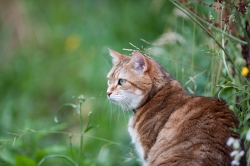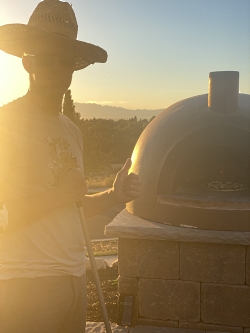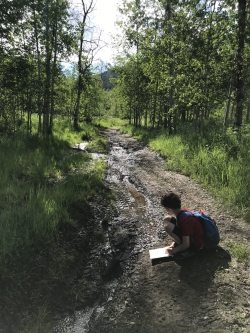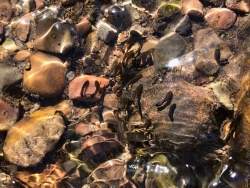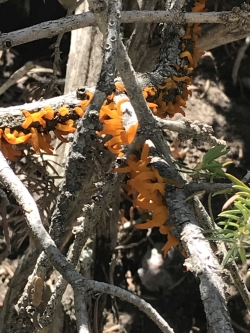
Melanerpes formicivorus
Courtesy US FWS,
Gary Kramer, Photographer
My first encounter with an acorn woodpecker occurred many years ago in California, a species unknown to me. I was surprised to find a small flock of these comedic looking birds- most unusual for woodpeckers, which are generally solitary other than with mates or young. And those startling yellow eyes!
On a recent West Rim trek in Zion N.P., to my delight, I got a second encounter near Potato Hollow. Their loud, sharp calls first alerted me. I paused to find the source, and was startled to see who it was, unaware they existed in our state.
Acorn woodpeckers live in large groups, hoard acorns, and breed cooperatively. These woodpeckers live in oak and mixed oak-evergreen forests on slopes and mountains in the Southwest and West Coast. They are found infrequently in the south end of our state. They’re tolerant of humans, and occur in towns where there are acorns and suitable places to store them.
If more than one female in a colony breeds, they lay eggs in the same nest cavity. When egg-laying is not synchronized, females often destroy each other’s eggs. In-synch egg-layers, however, produce a clutch totaling three to seven eggs. Although this behavior seems counterproductive, it may be beneficial, resulting in all chicks being roughly the same age and size. Several different individuals of each sex may breed within one family, with up to seven breeding males and three breeding females in one group.
All members of the colony share in incubation duties, and all pitch in to feed the chicks when they hatch. Young adults remain with their parents for several years to help raise successive broods, but eventually disperse to other territories. Nesting groups can contain up to ten offspring helpers. These breeding coalitions are typically closely related. The males are often brothers, and the females are usually sisters. Inbreeding is rare, however, meaning that co-breeders of the opposite sex are almost never related.
All members of an Acorn Woodpecker group spend large amounts of time storing acorns. typically stored in holes drilled into a single tree, called a granary tree. One granary tree may have up to 50,000 holes, each of which is generally filled with an acorn by autumn.
When any protective group of woodpeckers experiences a death or disruption to the hierarchy, nearby birds rush to the area and fight for access to the trove; these fights also attract woodpecker audiences who leave their own territories to witness the battles.
In 1923, American ornithologist William Leon Dawson called the dapper Acorn Woodpecker “our native aristocrat.” “He is unruffled by the operations of the human plebs in whatever disguise…Wigwams, haciendas, or university halls, what matter such frivolities, if only one may go calmly on with the main business of life, which is indubitably the hoarding of acorns.”
Jack Greene for Bridgerland Audubon Society and I’m totally wild about Utah and its acorns!
Credits:
Nest Picture: Courtesy US FWS, Gary Kramer, Photographer, https://digitalmedia.fws.gov/digital/collection/natdiglib/id/2755/rec/3
Audio: Courtesy and Copyright Kevin Colver, https://wildstore.wildsanctuary.com/collections/special-collections/kevin-colver
Text: Jack Greene, Bridgerland Audubon, https://bridgerlandaudubon.org/
Additional Reading: Lyle W Bingham, Webmaster, and Jack Greene, Author, Bridgerland Audubon, https://bridgerlandaudubon.org/
Additional Reading:
Acorn Woodpecker Overview, All About Birds, Cornell Lab of Ornithology, Cornell University, https://www.allaboutbirds.org/guide/Acorn_Woodpecker/overview
Acorn Woodpeckers, Species, Utah Division Wildlife Resources, Utah Department of Natural Resources, State of Utah, https://fieldguide.wildlife.utah.gov/?species=melanerpes%20formicivorus [Link updated January 2024]
DAWSON, William Leon, Islapedia, Santa Cruz Island Foundation(SCIF), https://www.islapedia.com/index.php?title=DAWSON,_William_Leon
Webinar: Adaptations of Acorn Woodpeckers with Sahas Barve, National Museum of Natural History, Science How, Smithsonian Institution, https://naturalhistory.si.edu/education/teaching-resources/life-science/webinar-adaptations-acorn-woodpeckers-sahas-barve
Murtaugh, Paul, Granary Tree Image, Oregon State University, sites.science.oregonstate.edu/~murtaugp/photos/jan2017/p12.html [Link broken and removed January 2024]
When It Comes to the Family Granary, an Acorn Woodpecker’s Work Is Never Done by BirdNote, Podcast, National Audubon, September 23, 2019, https://www.audubon.org/news/when-it-comes-family-granary-acorn-woodpeckers-work-never-done [Added January 2024]

